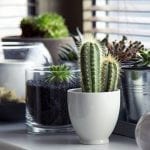
Grow Ferns Indoors: A Quick Guide to Adding Greenery to Your Home
With their long, feathery fronds and lush, exotic appearance, ferns make beautiful indoor plants. The humidity and moisture from your daily shower make the bathroom the best spot to grow ferns. If you’re interested in growing ferns indoors, in pots, or learning to cultivate ferns from spores, read on:
Ferns thrive in humid, moist environments. Some of the best fern varieties to grow indoors are listed below.
- Button Fern (Pellaea)
- Holly Fern (Cyrtomium)
- Boston Fern (Nephrolepis)
- Rabbit’s Foot Fern (Davallia)
- Staghorn Fern (Platycerium)
- Silver Lady Fern (Blechnum gibbum)
If you have a large bathroom, the broad, bushy foliage of a Silver Lady Fern plant will look attractive.
Grow Ferns in Pots With This Quick DIY
What You’ll Need To Grow Ferns:
- Decorative plant container
- Plastic pot to fit inside
- Bucket or container for mixing
- Small gravel
- Potting mix for houseplants
- Slow-release granular fertilizer
- Fern plant
Step 1
Pour houseplant potting soil mix into a bucket or container. Add a granular slow-release fertilizer, following packaging directions. Then, mix the potting soil and granules.
Step 2
Add a little gravel to the bottom of the plastic pot to improve drainage for the ferns. Then, pour the potting mix to fill the plastic pot halfway to the top.
Step 3
Remove any ferns from their original container and place them in the plastic pot. Fill around the roots and plant with additional potting soil/fertilizer blend. With your fingers, press the soil down gently around the plant.
Step 4
Add a thin layer of gravel on top of the potting soil and water the ferns well.
Caring for Your Fern
It’s easy to grow ferns as they are a very low-maintenance plant. Humidity, low light, and fertilizer are the necessities.
Humidity –
Ferns do not tolerate dry conditions. Ferns are woodland plants that naturally thrive in the shaded, moist soil under trees. You’ll know when your fern isn’t getting enough humidity when you notice the fronds begin to turn brown. Make sure your fern takes in plenty of moisture by:
- Keeping the potting soil damp but not soggy. You may need to water the plant a little daily.
- In the spring and summer, water ferns well. In the winter, water just until the soil is moist.
- Mist your fern with room temperature, soft water, preferably in the a.m.
- Fill a shallow tray with pebbles. Sit your fern on top. Finally, add enough water to the tray to touch the bottom of the pot.
Light requirements-
Ferns in their natural environment thrive in dappled sunlight, under the leafy canopy, and in the shade of trees. Your indoor fern will need a similar amount of bright, indirect light to grow.
You’ll know your fern isn’t getting enough light when you see slow growth and yellowing fronds. Few ferns will tolerate full sunlight and prefer the shade.
Fertilizer-
In the spring and summer, feed your fern every two to four weeks with a mixture of tepid water and a few drops of liquid fertilizer. Occasionally add a few drops of liquid fertilizer to your spray mister.
Ferns ‘sleep’ in the winter, so no feeding is required.
How to Grow Ferns from Spores
Patience and some skill are required when propagating new ferns from spores. Ferns are a unique plant because they reproduce by spores. Spores are in casings (sporangia) located on the underside of the fronds.
1- Locate the ripe spores by looking on the back of any ferns for cinnamon brown colored dots or lines.
2- Trim a frond section with pruning scissors. Place it between two sheets of paper loosely taped together.
3- Also, store the frond in a dry, warm, draft-free spot for approximately two weeks.
4- Carefully open the sheets of paper. You’ll see a mix of spores and leaf debris.
5- Separate the leaf debris from the spores by holding the sheet on a slant and lightly tapping the paper. Additionally, the heavier debris will fall from the paper. The lighter spores will remain stuck to the paper.
6- Gently fold the paper in half, lengthwise, and tap again to slide the spores into the fold.
7- Sprinkle the spores on top of the potting soil and place the pot near a window.
8- Patiently wait. It will take 6 to 8 weeks for tiny flat, leaf-like plants to appear. Also, keep the potting soil moist—thin the sprouts to one to two per 3″ area.
9- After another 6 to 8 weeks, little ferns will emerge. When the first fronds grow to 1/2″ in height, thin the fronds to 3″ apart.
10- Lastly, plant your new ferns in an area with shade. Check them regularly in the first year to ensure they have plenty of water and a humid environment to grow. This includes checking to see if the fronds are browning.
Adding greenery to your home can give any room a fresh look. Ferns especially make the perfect addition to any bathroom. The simple necessities of humidity, low light, shade, and fertilizer make growing a fern in your bathroom simple.
Find out which indoor plant suits your bathroom best here.
Want to learn the best tips about fall gardening? Click here.














